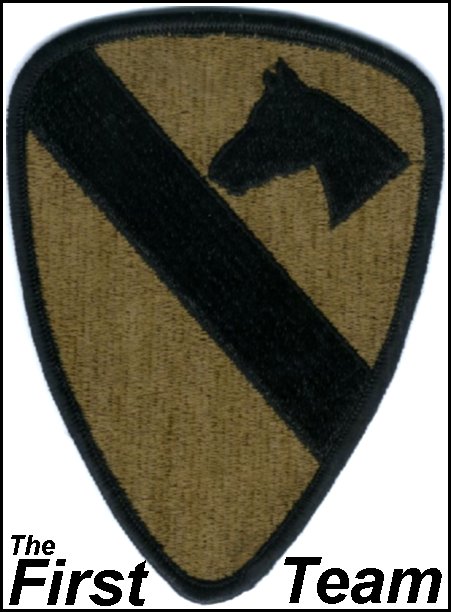
My Vietnam Tour:
1st Air Cavalry Division
March through December, 1970
Michael J. Everhart, 1LT
U.S. Army Chemical Corps
Page created July 28, 2013 - Copyright ©2013-2014 by Mike Everhart
Updated July 7, 2014
 |
My Vietnam Tour: 1st Air Cavalry Division March through December, 1970 Michael J. Everhart, 1LT
Page created July 28, 2013 - Copyright ©2013-2014 by Mike Everhart Updated July 7, 2014 |
|
|
My family has an unspoken military tradition going back to the Spanish American War in my direct lineage. My grandfather, Frank A. Everhart, served in the Army in the Philippines during the Philippine Insurrection and my father, Jack M. Everhart, served in the Marines in the South Pacific during World War II (and my mother, Betty Qualheim, and uncle, Robert Qualheim, were also WWII Marines). My brother, David, served in Vietnam (1970) with the Marines the same time I was there and my son is currently in the military and just back from Afghanistan. There was never any pressure for me to join the military, but in my mind there was no question that I would do so, either. When I enrolled at Wichita State University near the beginning of the war in Vietnam, I signed up for Army ROTC (Reserve Officers Training Corps). Actually I would have preferred to be in Naval ROTC to pursue a commission in the Marines, but bad eyes made that impossible. In ROTC, I did well and did my nine weeks of ROTC Summer Camp at Fort Riley, Kansas between my Junior and Senior years. I was a Battalion Commander during my Senior year, and received my Regular Army (RA) commission in May, 1968 as a Distinguished Military Graduate (DMG). I stayed an additional semester in the Fall of 1968 to finish my Bachelor of Science Degree and went on active duty in March, 1969, at Fort McClellan, Alabama in my Chemical Officers Basic Course (COBC).
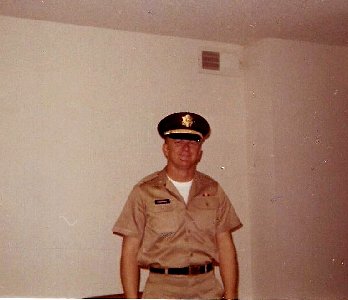 |
Newly commissioned as a 2nd Lieutenant, I was assigned to
the Chemical Officers Basic Course 1969-5, Fort McClellan,
Alabama. Our training consisted of a lot of classroom work and field exercises involving chemical,
biological and radiological (nuclear) weapons. Most of us were convinced
that no one in their right mind would ever use those weapons in combat
again. Unfortunately, we were wrong, at least in terms of chemical weapons
(Iraq-Iran war, etc.)
Here's a picture of the guidon that I designed for our basic officers course... The dragon was a bit more fierce looking in my drawing, but lost something when translated to cloth by the officer's wives. LEFT: Summer uniform at Fort McClellan, Alabama RIGHT: Back from night compass training with one of my classmates. |
 |
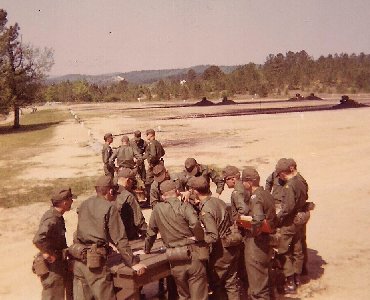 |
LEFT: Out on the range with real explosives - blowing up things was fun! RIGHT: We had a quite a few people come to talk to us about the conditions and what to expect in Vietnam. |
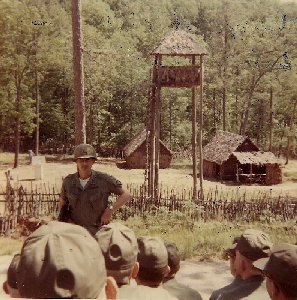 |
 |
LEFT:
This was our first exposure to helicopter missions. We flew an exercise
six students at a time over the range at Fort McClellan. This was the
group ahead of me. RIGHT: Off they go. Note that there are no guns on this helicopter and the doors are shut. Not at all like normal operations in Vietnam. |
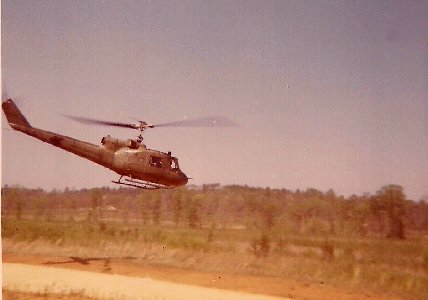 |
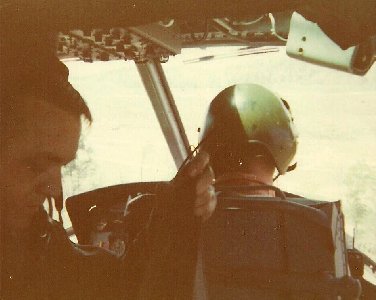 |
LEFT: My first flight in a UH-1 Huey. Of all things, we
were doing an aerial radiation survey. Little did I know at the time that I would
be flying real missions in helicopters in Vietnam in less than a year.
RIGHT: May, 1969 - This photo was taken during our 3-day field exercise during the last week of the school. The exercise included an "Escape and Evasion" course on the last night. I was determined to not be captured and led five other guys out of the woods early the next morning. We were the only ones out of a class of 24 that successfully evaded capture by the 'enemy.' After hearing the stories about the 'prison of war camp' from the rest of my classmates, I was happy to have declined the opportunity. From there I went all the way back to Fort Riley, Kansas; it was not exactly my idea of joining the Army to see the world. I served as the Post Chemical Officer for about eight months before getting my orders for Vietnam. |
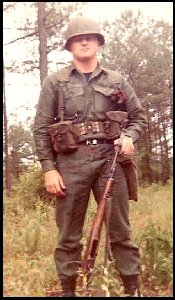 |
After finishing my COBC, I was assigned to, of all places (!?!?), Fort Riley, Kansas, less than 150 miles from home. Initially I was to be a platoon leader in a Chemical (Smoke) Company, but the Army had an immediate vacancy at Post Headquarters. After a week or so, I replaced a 1st Lieutenant as the Post Chemical Officer. The job actually called for a Major, but field grade Chemical officers were in short supply, so I was given the 'opportunity' as a very green 2nd Lieutenant. The assignment was relatively uneventful, but in January, 1970, I received orders for Vietnam. I had thirty days leave and then left for Vietnam almost a year to the day from when I went on active duty.
My tour in Vietnam lasted about 10 months before I took an "early out" to return to graduate school. I had a great assignment with the 1st Air Cavalry Division, Headquarters Chemical Section at Camp Gorvad (near the small town of Phouc Vinh, about 40 miles (60 km) north of Saigon). Most of the time, it was a "desk job" but I also flew in helicopters as mission commander on aerial herbicide spray and terrain denial missions. A "desk job" is probably an understatement of sorts.... Camp Gorvad was a forward operating base for a very aggressive, air mobile cavalry division. There were no horses in our cavalry; we flew everywhere in helicopters. That made Camp Gorvad a prime target for the local VC and NVA. We were attacked by indirect mortar and rocket fire (mostly 122 mm Katyusha rockets) on a regular basis which caused casualties, and damaged equipment and buildings. That said, we were not targeted by a ground attack while I was there.
President Nixon banned the use of the Agent Orange defoliant in April, 1970 and the Cambodian incursion started as a massive surprise attack on May 1, 1970. The Chemical Section was pretty much grounded during that time because all of our helicopter assets were being used to support troops in the field. The war itself was winding down and troops were coming home. I became interested in the environment (1970 was the first Earth Day) and I reconsidered my decision to make the Army a career. I applied for and was accepted into Graduate School at Wichita State University and the Army approved my early release. I left Vietnam on New Years Eve, 1970, and became a civilian again.
NOTE: The following photos were mostly taken during my tour in Vietnam. I was very much an amateur photographer at the time. In fact, my first photos in Vietnam were taken with a Polaroid Land (instant) camera that I brought with me. That camera corroded quickly in the hot, humid environment and was sent home (never made it, but that's another story). Next I bought a 35 mm Miranda Sensorex camera (my first experience with 35 mm film). It lasted maybe a month before the shutter mechanism died and I exchanged it for a Pentax Spotmatic at the base PX (that camera lasted for more than 30 years and was finally replaced by my first digital camera). The Pentax SLR was all manual, something I grew to love, but the quality of my early photos varies a lot due my inexperience with f-stop and shutter speed. Many of the aerial shots I took are somewhat blurry due to speed and vibration. Note, however, that the basic color of Vietnam is reddish-brown, not green. The red laterite soil permeated everything where I was stationed. Even during the monsoon season, it could rain at night and by noon the next day there was red dust in the air around our base.
I was also using any film (Kodak) that I could get at the base PX - high speed black and white, color print and various color slide films. Some of the exposed film was developed in Vietnam and many of the finished photos have a 'muddy' look that comes from using depleted developing solutions. Other rolls were sent to a U.S. facility in Japan and usually turned out better. And of course, most of the color prints and slides have faded or otherwise lost their original color. The prints were scanned on my flatbed scanner and the color slides converted directly to digital. In the digital format, I was able to correct for some of the color changes. While I wish the photos had turned out better, they do reflect many of my experiences in Vietnam.
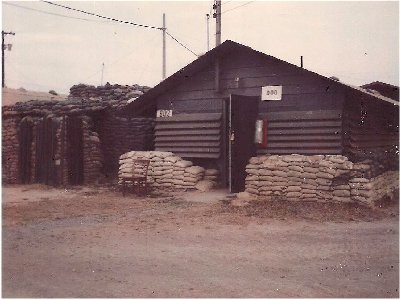 |
LEFT:
After
arriving in Vietnam, we were all loaded on a bus and
sent to the 90th Replacement Detachment to be issued our basic stuff - jungle
fatigues, jungle boots, etc. (7 March 1970) - I spent my first
few nights in Vietnam sleeping on an army cot in this BOQ - "Bachelor
Officers Quarters." It took a while to get used all of the different
noises, but I slept pretty well getting over jet lag.
Note the sandbags around the lower level of the building - Meant to give some protection to the occupants from a mortar attack. RIGHT: Just another "new guy" after arriving in country at Ben Hoa, Vietnam, March 1970. Brand new, clean and unfaded jungle fatigues make you stand out in a crowd. |
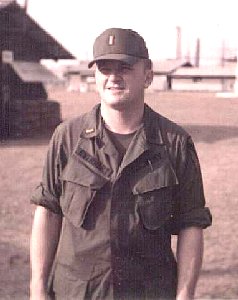 |
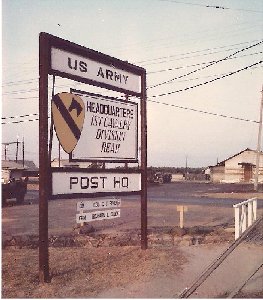 |
LEFT: Division
Rear" was the area in Binh Hoa where all the "new guys"
came into the 1st Cavalry Division... got some minimal training (Vietnam
familiarization) and then were re-assigned to their new units out in the
bush. The one training exercise I remember was rappelling backwards off a
60 foot high wooden tower. This was supposed to simulate inserting into
the jungle from a hovering helicopter. I had never done anything like it
before, but because I was the only officer in the group, the NCO 'jump
master' picked me to go first..."Just stand on the edge, lean back
and push off." Worked like a charm, but thankfully I never had the
opportunity to do it for real. RIGHT: Last view of the flags at Division Rear, 1st Cavalry Division. I spent the five days there for training before going to Headquarters, 1st Cavalry Division. Then I took a helicopter ride to Camp Gorvad (III Corps) near the small town of Phouc Vinh in central Vietnam. My memory of the first few days is just a blur. |
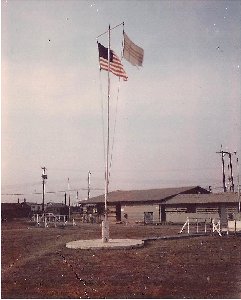 |
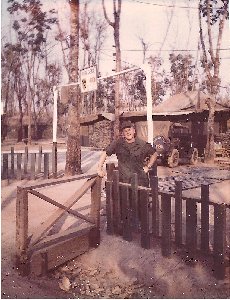 |
LEFT: 18
March 1970 - Welcome to the Chemical Section,
Headquarters, 1st
Cavalry Division, Camp Gorvad, Phouc Vinh, Vietnam (about 40 miles north
of Saigon, now Ho Chi Minh City). First
day in the new job... RIGHT: 21 March 1970 - The backside of our office (metal roof with sandbags). I had been in country about 2 weeks and had already gone 'casual.' |
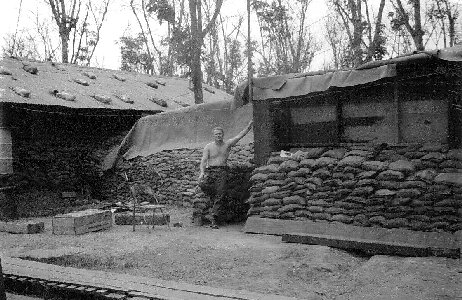 |
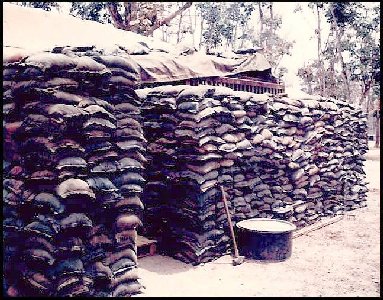 |
LEFT: - My first home... a salvaged
steel CONEX (CONtinental EXpress) shipping container covered with sandbags... It may look ugly, but it
was dry and relatively cool inside, and I didn't have to worry about incoming
mortar rounds
RIGHT: My "corner office" .... just inside the front door of the Division Chemical Section, HQ, 1st Air Cavalry Division. Although the Coke can sitting by the telephone looks up-to-date, it was still made out of steel and had to be opened with a "church key" or beer can opener which we all carried. |
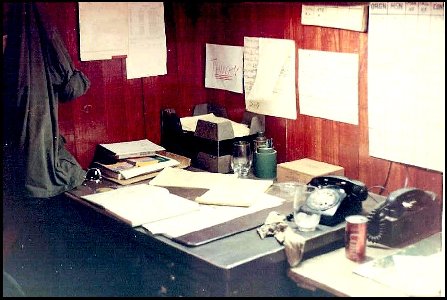 |
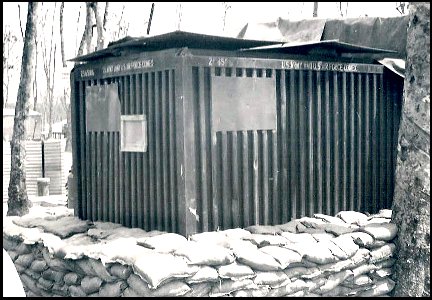 |
LEFT: This
is the newly acquired CONEX (shipping) container that I lived in for almost 10 months
while I was in Vietnam. It was about 7' high by 8' wide and about 12' long....
small but cozy... three feet of sand bags on the top and sides protected
it from just about anything the NVA was shooting at us...and kept it
reasonably cool inside. Although they were re-usable for shipping, many
were damaged along the way and were not economically repairable... so we
got them from salvage and turned them into sleeping quarters. Most troops
at Camp Gorvad slept in wooden, well ventilated buildings with tin roofs
like my BOQ at Binh Hoa (above); I
think we slept better.
RIGHT: This was the inside of my quarters just after I moved in. I started improving it almost immediately in my spare time. The fan at the little window ran continuously 24-7. Part of my off-duty routine was to completely disassemble it every week, clean and oil it. It never gave me any trouble and was still running 24-7 when I left. The mosquito netting was required by regulation, but truth be told, our medical section (over)sprayed enough Malathion around the base that there were no mosquitoes... never had a mosquito bite. Of course, there were very few other insects or any birds there either. Still have the camo poncho liner lying on the bed. |
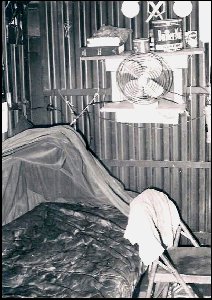 |
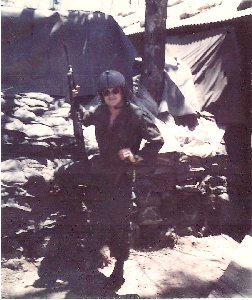 |
LEFT:
With people going home on regular basis, I moved right into the flight
schedule for our chemical missions, flight suit, helmet and all. RIGHT: One of our Captains was leaving soon and wanted to get a picture of himself sitting in a helicopter (in this case, an LOH)... We used one on the flight line and everyone got the chance to look like a 'pilot for a minute.' |
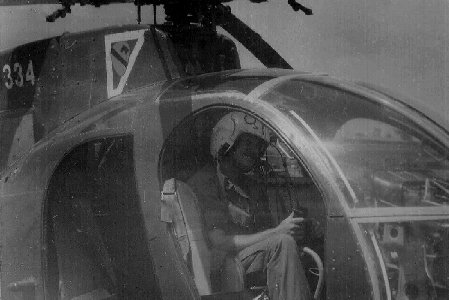 |
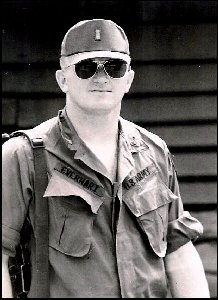
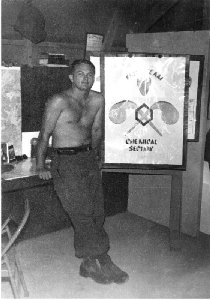 |
FAR LEFT: Still
a 2nd Lieutenant, but definitely part of the First Team...
LEFT: I was low man on the totem pole in the Chemical Section, working with several captains and a Lieutenant Colonel. When LTC Templeton learned that I had a little bit of artistic talent, I was immediately promoted to "Chart Meister." I prepared all of our flip charts and was there to turn them whenever the boss needed to brief an incoming officer on what the Chemical Section did.... One of my more humorous efforts. RIGHT: A map of the area of South Vietnam where I was stationed in 1970. Note that Saigon is now "Ho Chi Minh City." Red circles are places mentioned in this web page. The distance between Binh Hoa and Tay Ninh is about 45 miles (by air). |
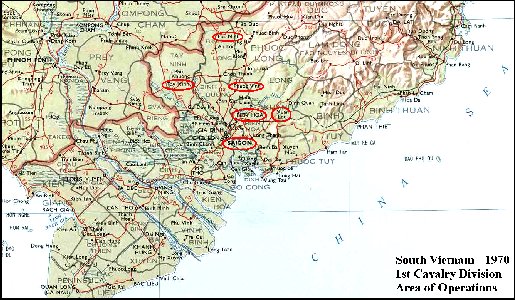 |
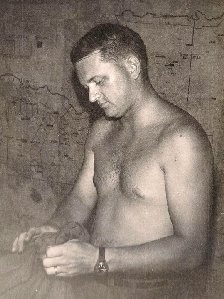 |
LEFT: Just
me in front of our III Corps situation map... Cambodia at the top, Vietnam
below the line. Theoretically we were on duty 24-7, but did most of our
work during the day. Office hours in the evening were used for reports,
updating the situation map and planning missions. Holidays and weekends
were just "suggestions."
RIGHT: This map was probably "classified" at some point, although it was never marked that way.... Each of the little pins represents an NVA cache or storage site discovered in Cambodia.. all of which were captured or destroyed in the 1970 incursion. Most were simply blown up, but some of the equipment and weapons were brought back to our bases in Vietnam. This is the so-called "Parrots Beak" region of Cambodia. |
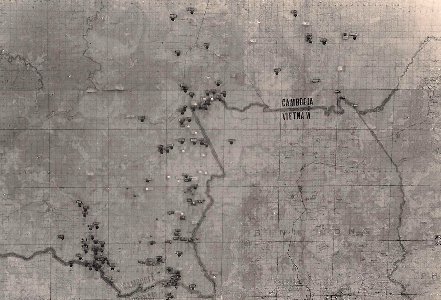 |
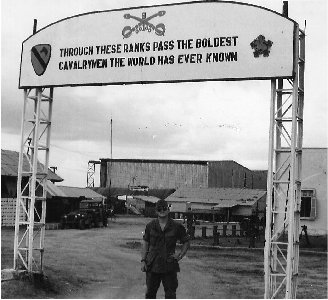 |
LEFT: 1st Battalion of the 9th Cavalry Regiment, 1st
Cav all the way, but not my unit ... VIDEO
... The 1/9th was stationed at Fort Riley, Kansas, from 1881 to 1885.
Another 1/9 at Camp Gorvad webpage RIGHT: Fifty-five gallon drums of Agent Orange herbicide (defoliant) in our storage yard... Agent Orange was banned for use in April 1970 by President Nixon. |
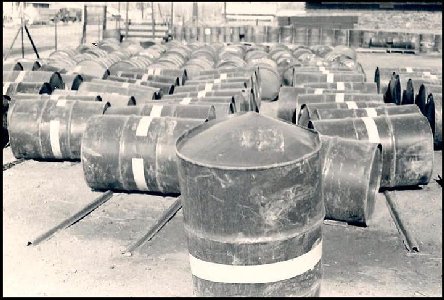 |
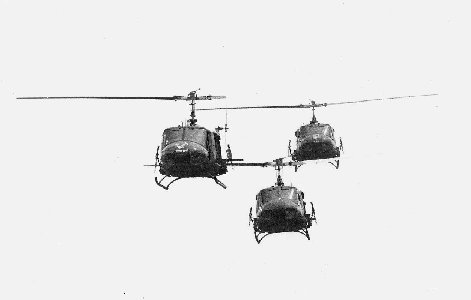 |
LEFT: Three
UH-1 Hueys inbound to Camp Gorvad. Note
that
this
photo
was
taken with a telephoto lens....the helicopters are actually a safe
distance apart... not on top of each other...
RIGHT: UH-1 Huey helicopter being used for herbicide spray operations.. denying crops to the VC / NVA... |
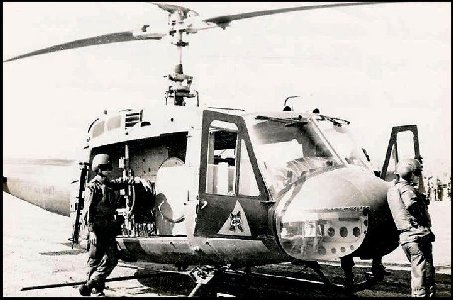 |
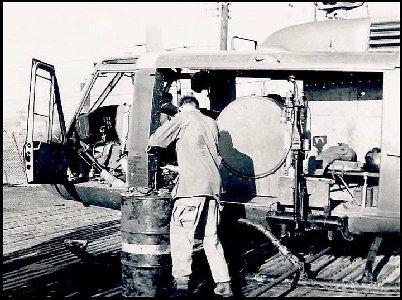 |
LEFT: Loading Agent Orange using a hand pump.
Unfortunately, we didn't know about the dangers of exposure to the dioxin
and other contaminants in Agent
Orange at that time.
RIGHT: Not all of our spray missions were in enemy territory... Here we are spraying diesel fuel to kill the elephant grass growing around our base at Thien Ngon ... a never ending problem in a jungle environment. And, yes, we were literally flying just above the vegetation. |
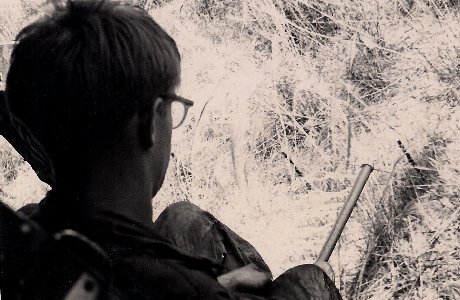 |
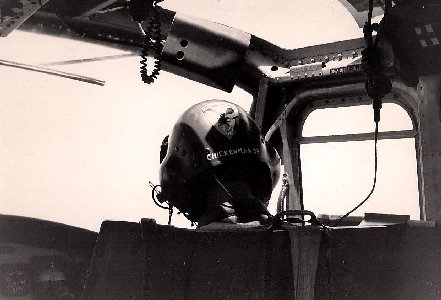 |
LEFT: ChickenMan29...
right seat pilot of a UH-1 Huey.. these guys average age was 20... and
they were they best helicopter pilots in the world...
RIGHT: The view from my station looking out the front of a UH-1 Huey in flight. |
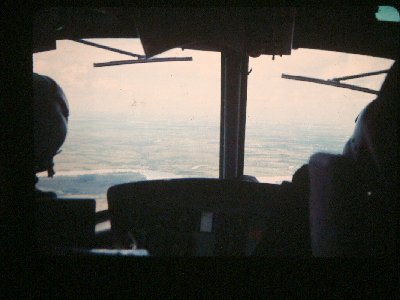 |
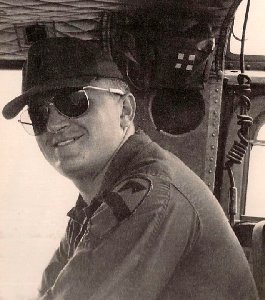 |
LEFT: Me as Mission Commander, sitting
behind the command pilot in a UH-1 Huey..
RIGHT: This is a view looking behind my seat in the Huey.. the gunner's M-60 machine gun. The ground was obscured by low clouds. We were flying above 4000 feet where the air was reasonably cool and dry.... a real treat. FAR RIGHT: 1LT Tinsley, our Chemical Operations Officer... He was the guy that kept our missions going. |
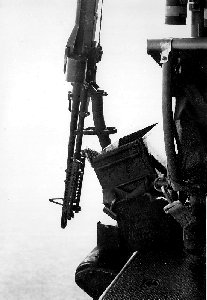
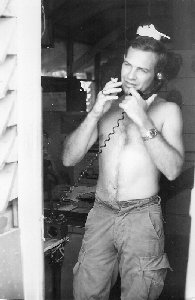 |
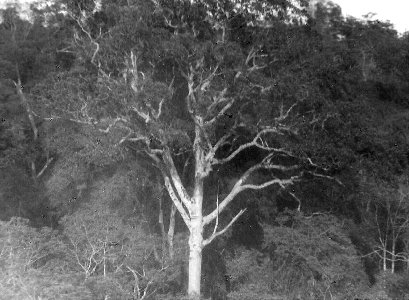 |
LEFT: Nice
tree photo... problem was that we were flying down a valley below it...
Anybody with a rock could have thrown it and hit us.....
RIGHT: A scenic view near Nui Ba Dinh mountain... |
 |
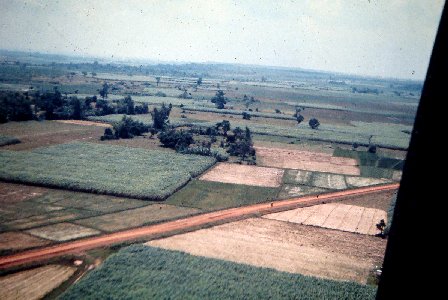 |
LEFT: Aerial view of the peaceful countryside...mostly rice
paddies. Note foot traffic on road. RIGHT: Aerial view of the countryside...again mostly rice paddies. There is a farmer working his paddy at right. What most of us failed to realize was that even though there was a war going on, there were about 20 million Vietnamese in South Vietnam just trying to make a living and raise their children. Most of the country was not in the fight... there were no front lines and the contrast was startling at times. |
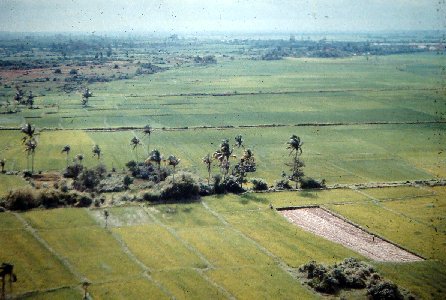 |
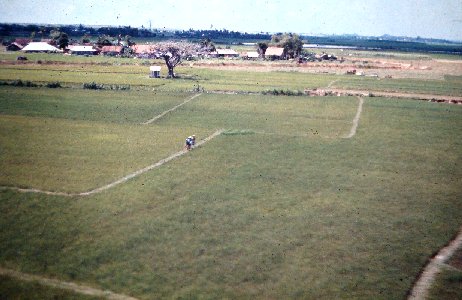 |
LEFT: Aerial view of the countryside...more rice
paddies. There is a family walking along a path between the fields. RIGHT: Aerial view of the countryside...mostly rice paddies again. Quite a few shell craters at right. |
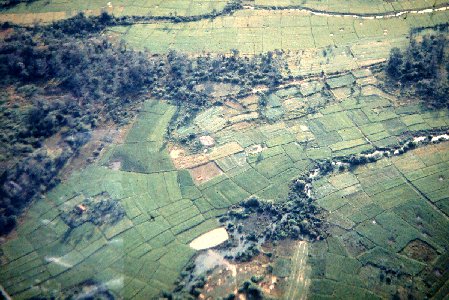 |
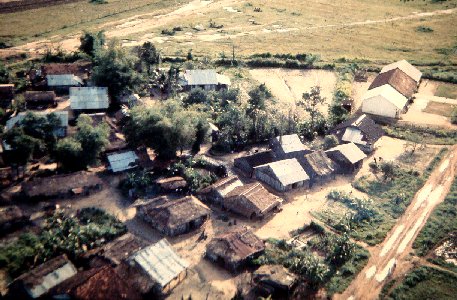 |
LEFT: Small rural village. The puddles on the
road indicate this was taken during the rainy season (May-September). In
1970 while I was there, Vietnam experienced the worst monsoon season in
six years, with heavy flooding in some areas. RIGHT: Rural farm building surrounded by crops. |
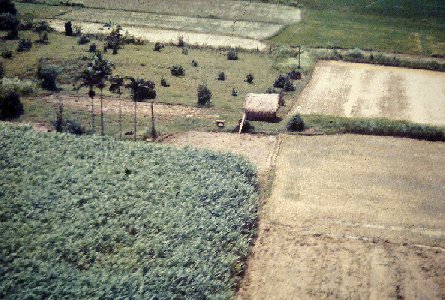 |
 |
LEFT: Farmer using two water buffalo to plow his
rice paddy. RIGHT: I thought this was a cemetery, but it appears to be surrounded by some old ruins. |
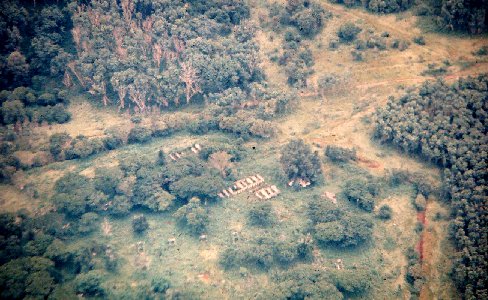 |
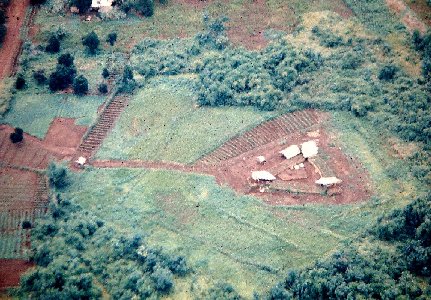 |
LEFT: Small fortified hamlet, possibly Montagnard
(indigenous people of the mountains).
RIGHT: Small fortified hamlet, possibly Montagnard.
|
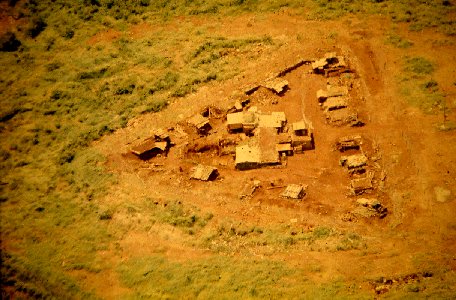 |
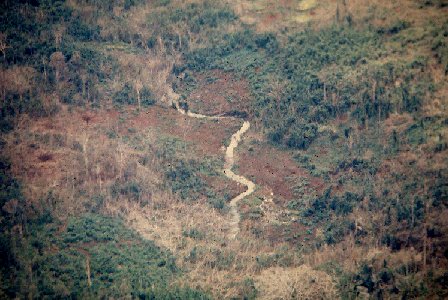 |
LEFT: Small stream n valley. The cleared areas have
been used for crops, probably grown by the Viet Cong (VC) - North
Vietnamese Army (NVA). RIGHT: Hillside along a valley in the uplands, possibly along the flank of Nui Ba Dinh Mountain.
|
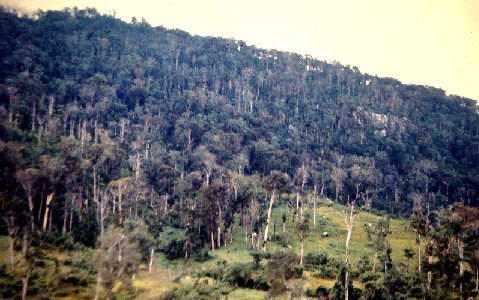 |
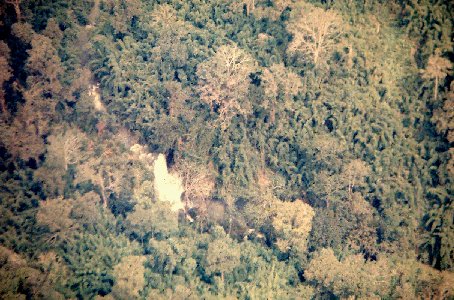 |
LEFT: A waterfall in the hills... A one point, I
thought I might want to come back to this place... RIGHT: Typical jungle scene in low level flight.
|
 |
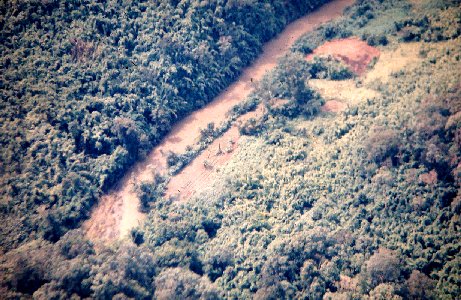 |
LEFT: A destroyed NVA garden along a muddy stream. In many
cases, the NVA were 'living' off the land, supplementing their rice with
garden vegetables. RIGHT: Sinuous path of the Song Be River.
|
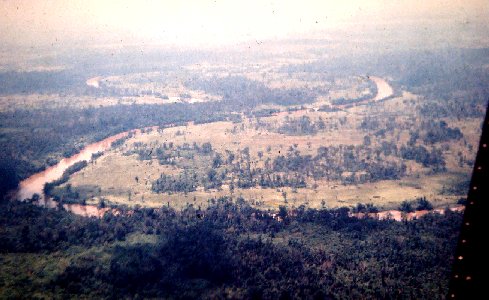 |
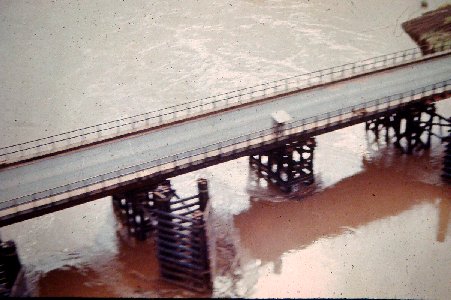 |
LEFT: A bridge over the Song Be River. RIGHT: Another, more substantial bridge over the Song Be River. This one may date back to the French occupation of Vietnam. |
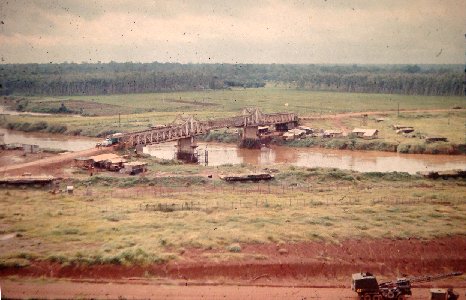 |
 |
LEFT: Boat
traffic on a river near Saigon. RIGHT: This was a navy patrol boat on a river near Saigon. |
 |
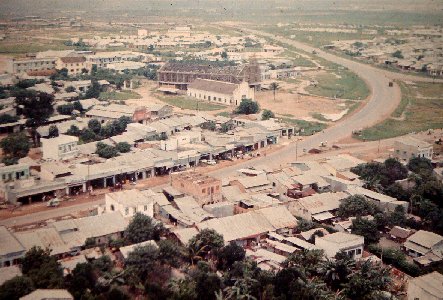 |
LEFT: This is a view of the highway and some of the town
of Binh Hoa, on the way in from Camp Gorvad.
RIGHT: A closer view of the shops along the highway. |
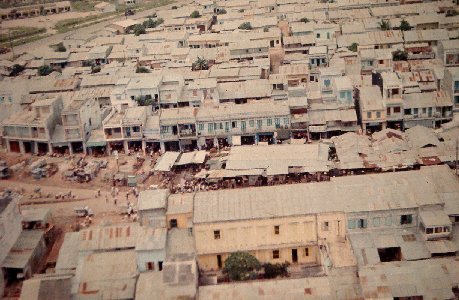 |
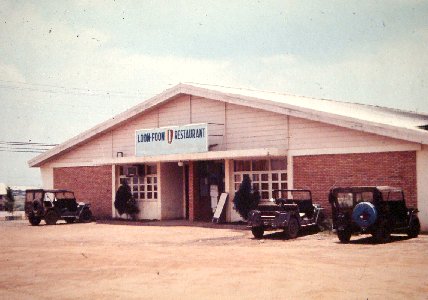 |
LEFT: One time when we were in Binh Hoa, we told our
helicopter crew that we should stop for lunch at a local Chinese restaurant. They
didn't need much convincing.
RIGHT: Inside was a totally different world from where we had just been... air conditioning, waitresses, printed menus and good food. They even brought us warm wash clothes to wipe our hands before eating.... |
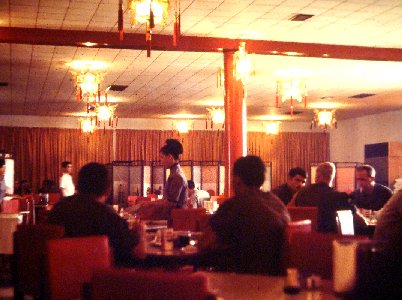 |
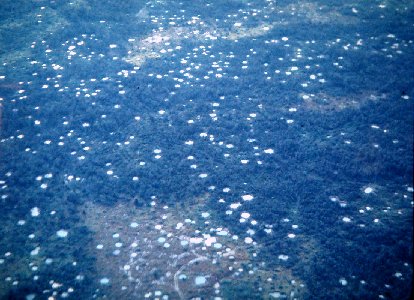 |
LEFT: Water filled shell craters during the monsoon
season. These were made by artillery shells, not bombs. RIGHT: More shell craters... in some cases the color of the water changed from crater to crater. |
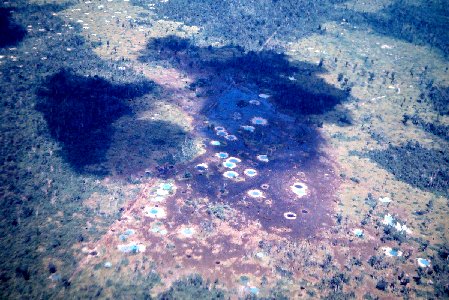 |
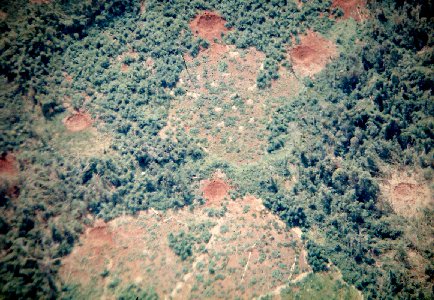 |
LEFT: Dry season shell craters. The red soil is laterite.
RIGHT: The Song Be River carried a lot of muddy water during the monsoon season. |
 |
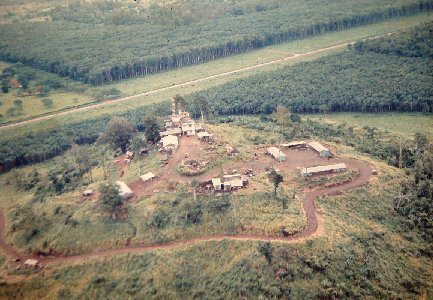 |
LEFT: This was originally a facility to gathering sap
(latex) from the rubber trees in the background. It is not fortified, so
it may have still been in use. Even during the war, latex was still being
produced on an industrial scale. RIGHT: Part of a Michelin rubber plantation. I think it's interesting that we talk about the effects of the American use of defoliants in Vietnam, but say nothing about the French totally destroying the original tropical forest and planting a monoculture of millions of rubber trees (a non-native species from Brazil). |
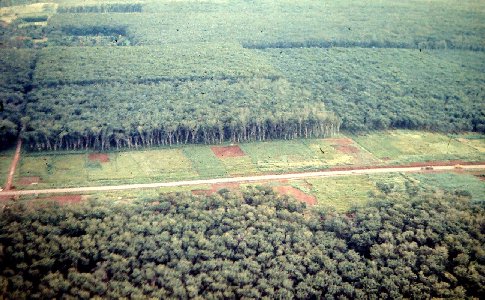 |
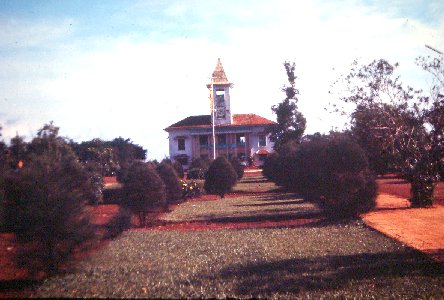 |
LEFT: Early in my tour, we had the opportunity to visit
what I think was a Catholic mission in our area of operations. The place
was really beautiful and well-maintained. It didn't look like the war was
anywhere close.
RIGHT: Part of the well-maintained grounds. |
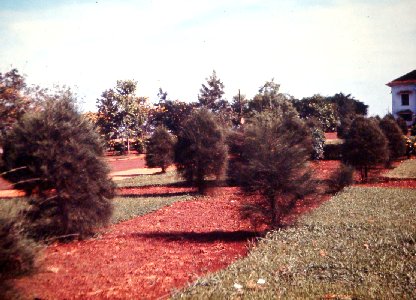 |
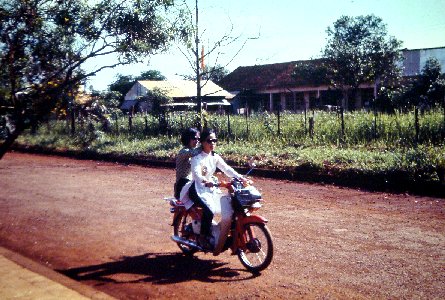 |
LEFT: Two Vietnamese women on a motorbike... the main
form of personal transportation in the country.
RIGHT: Staff at the mission leaving around lunchtime. The mountain in the background is probably Nu Ba Dinh. The women are wearing the traditional Vietnamese dress (Ao dai). |
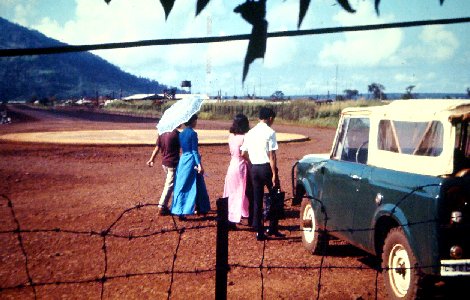 |
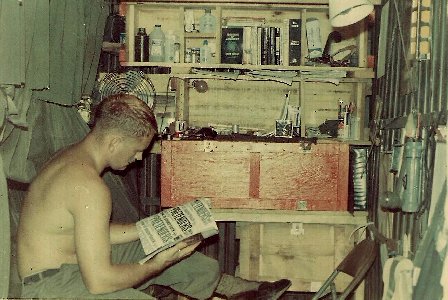 |
LEFT: Inside
my quarters (hooch), sitting on my bunk in front of my really nice custom
built book shelves and storage cabinets... (salvaged wooden ammo boxes).
RIGHT: Down time... checking up on someone else's war... |
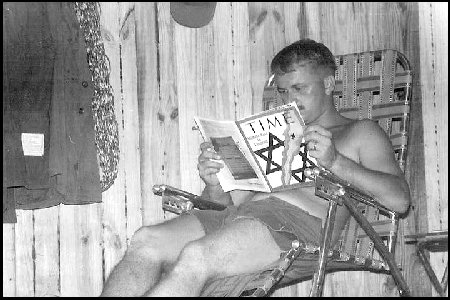 |
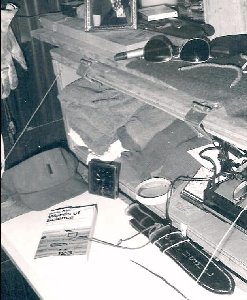 |
LEFT: Inside my drop-front desk. It's amazing how much stuff I began to accumulate. The combat knife and scabbard (USMC) were made by my Dad while serving in the Marines in the South Pacific during World War II. About the only thing I used it for in Vietnam was to slice up a fresh pineapple. RIGHT: Another view of my homebuilt storage (salvaged ammo boxes). The book at top right is The Source by James A. Michner, which I read on the flight to Vietnam. Bug spray at upper left, camera gear at lower right and tape recorder in the center. |
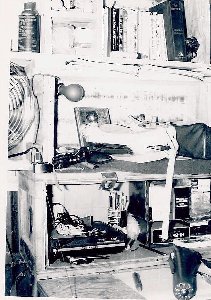 |
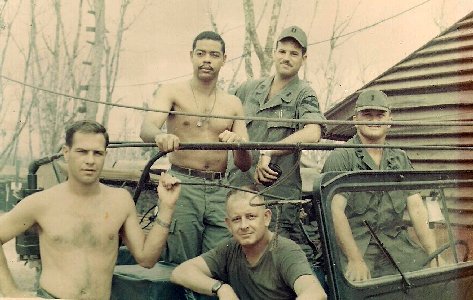 |
LEFT: Officers of the
1st Air Cavalry Division Chemical Section, outside our office, May 1970...
CPT Johnson (L) and CPT Gordon standing behind me. LTC James Templeton
sitting and 1LT Tinsley standing at left. Bad position on my part..... LOL. I was junior to all of
them in rank and time in country... All went home safely before I did.
RIGHT: The 1st Cavalry Division Chemical Team, including all the Brigade Chemical Officers, with me standing next to my boss, LTC Templeton, taken in October, 1970. At least I outranked some of these guys. CPT Fred Smith (far left) was KIA on Feb. 13, 1971. |
 |
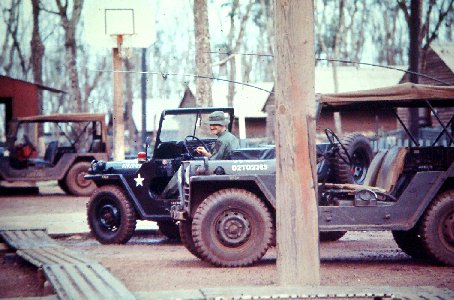 |
LEFT: For some reason, the General's driver was
visiting us at the Division Chemical office. RIGHT: Here's the front end of General Casey's well maintained jeep. |
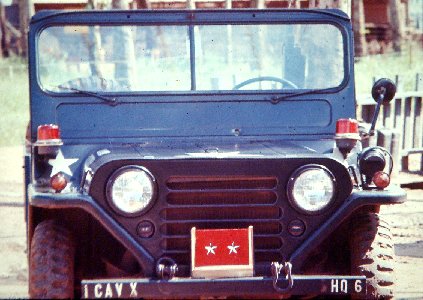 |
 |
LEFT: Promoted
to 1st Lieutenant!... COL. Whitehouse from MACV pinned my new bar. I was sure happy to get rid of that
"butter bar" on my collar...
RIGHT: The Division Chemical sign outside our office, a bit worse for wear. |
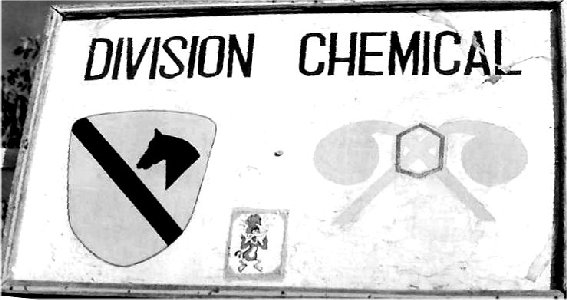 |
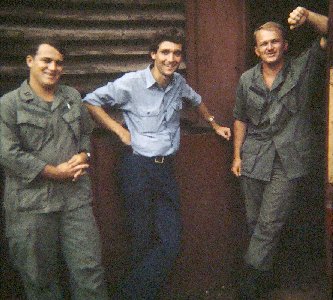 |
LEFT: Without realizing it at the time, we became
involved in a major study of the effects of herbicide use in Vietnam. The
Captain and I were just passing the time of day with the young man from
Yale. RIGHT: Here one of the principal investigators is interviewing my boss and our Sergeant Major. The report was published in 1973. |
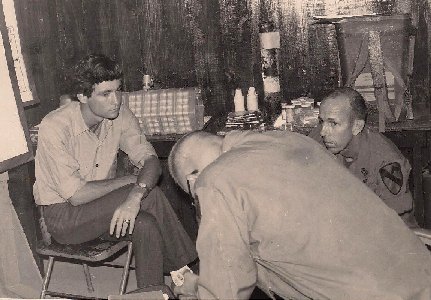 |
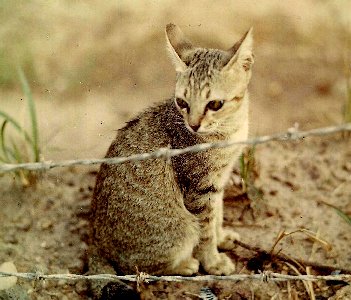 |
LEFT: Blue
Max... Big ears, long back legs and a bobbed tail... and an definite cat-titude.
I'm certain he was part wild jungle cat. His name came from a 1966 movie
by
the same name.
One
of our Cobra (Aerial
Rocket Artillery -ARA)
units also
used the Blue Max as their
symbol.... Bunch of crazy pilots (but very good!)...
The
cat also
acted
crazy from time to time....
RIGHT: Blue Max being just a cat.... doing what cats do best. |
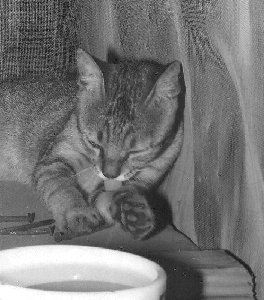 |
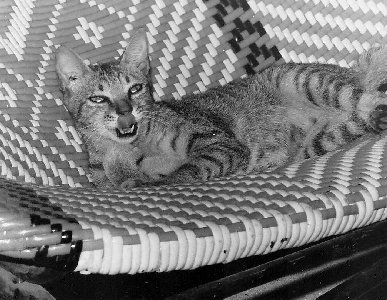 |
LEFT:
Blue Max and his "rightful place" in the middle of a wicker
couch.
RIGHT: Clean up time. |
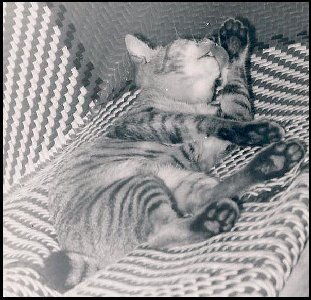 |
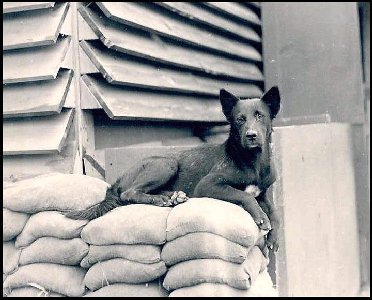 |
LEFT:
Charlie,
our camp follower dog.... A Heinz 57 mongrel, but basically a good dog. RIGHT: Charlie and one of the pups, probably LT |
 |
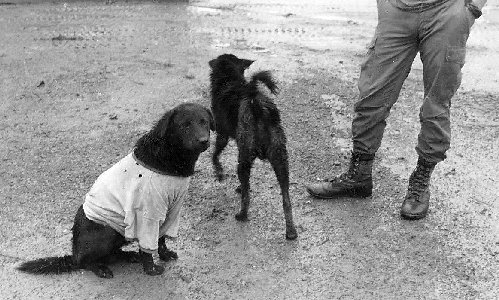 |
LEFT:
Wet as a dog... Charlie and LT (in the wet T-shirt).
RIGHT: LT was a friendly dog... although he looked sad most of the time. |
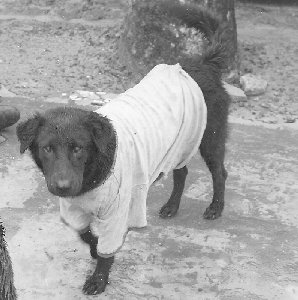 |
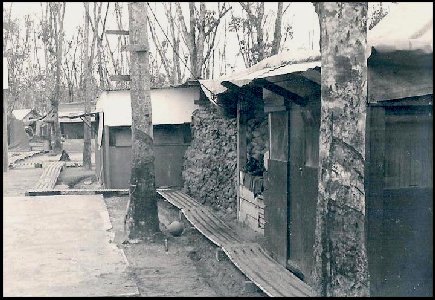 |
LEFT: This
is the front of the enlisted and the officers quarters for the Division
Chemical Section... the metal walkways allowed us to keep our feet
reasonably dry during the rainy season.... Note the dying rubber trees,
damaged by defoliant spray around our perimeter. You can still the cuts
made on these trees for harvesting latex.
RIGHT: NCO quarters... in our housing area --- more dying rubber trees. Lots of above ground walkways for the rainy season. The soil between the trees had literally turned to rock - laterite. Nothing grew on it. |
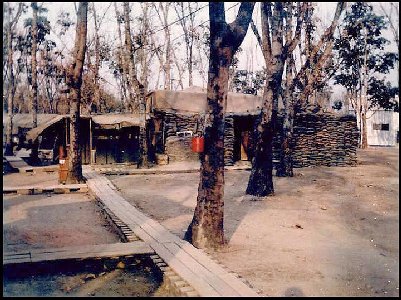 |
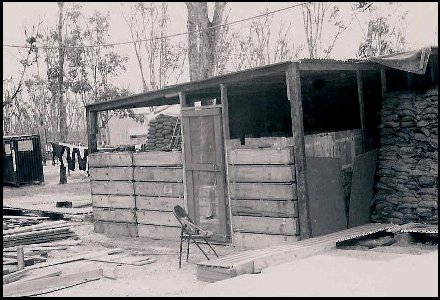 |
LEFT: During the inclusion into Cambodia in 1970, we were
unable to conduct herbicide missions. The helicopters were needed to
support the troops in the field. We used the time to construct an
enclosure in front of our quarters. We filled empty ammunition boxes with
dirt and stacked them to form a wall. They were covered with scrap plywood
on the outside and paneled with boards from other ammo boxes... then we
poured a concrete floor ... and set up shop. Pretty soon we had furniture,
a refrigerator and a small black and white TV.... actually could get
several channels including the Armed Forces Network (AFVN).
RIGHT: SP5 Wortz trimming off the boards used to support the rubberized canvas roof. He hated to just sit around, and was generally busy all the time, doing something around our area. |
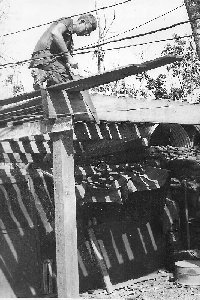 |
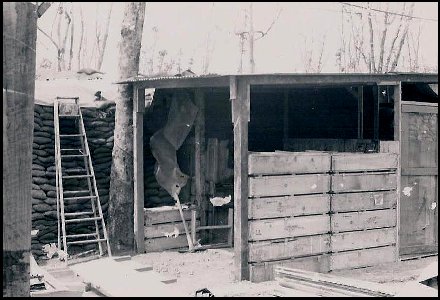 |
LEFT:
The remaining open wall before it was closed off. The roof
was boards covered with rubberized canvas .... no
leaks. RIGHT: Another view of the addition to the officers quarters ... Our shower at left. The window to my room is in the center of the photos.... Obviously I didn't have much of a view. To our credit, most of the structures in our end of Camp Gorvad were built around the remaining rubber trees (If for no other reason than them being extremely difficult to remove) |
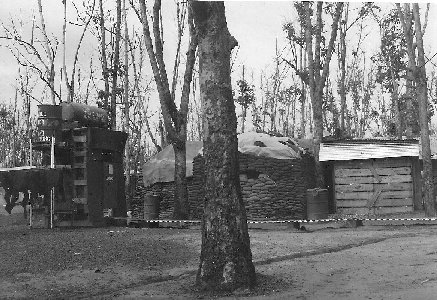 |
 |
LEFT:
Construction
finished, just needs some paint. Another
view here. RIGHT: This is the entrance to our newly painted Officers quarters (hooch)... Why did we paint it red?.... Well, that was the only paint we could scrounge up at the time.... |
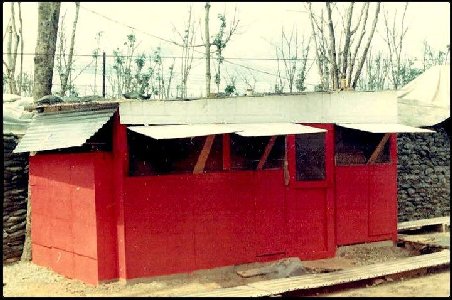 |
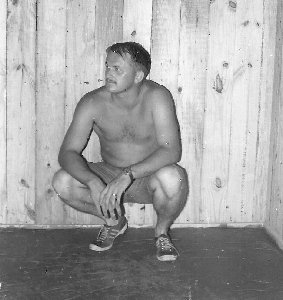 |
Once the addition was enclosed, we needed to pour a
concrete floor. We had bags of cement, but no sand, so 1LT Tinsley and I
borrowed a truck from the 184th and drove down to a bridge over the Song
Be River. We loaded up a bunch of river sand and brought it back. In
hindsight, it was probably the stupidest thing I did while there.
LEFT: The last thing we did was hand mix, pour and finish a concrete floor for the "officer's club" (SGT Callahan did most of the 'finishing;)...hot and sweaty work in Vietnam. The knotty pine paneling on the wall was salvaged from ammo boxes. RIGHT: Getting a cold one after a mission. Beer and soft drinks were trucked up by convoy, along with other more essential supplies, from Binh Hoa several times a month. Sometimes the metal shipping containers sat for days in the hot sun... Not good for treatment for beer. |
 |
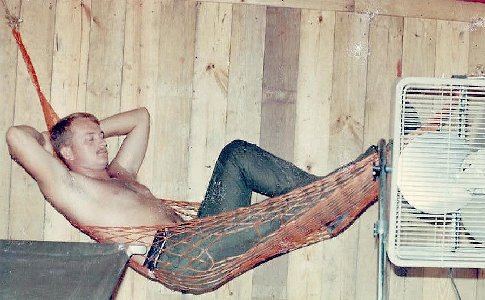 |
LEFT: IT didn't take long for us to install a few creature
comforts...like this cheap nylon hammock.
RIGHT: Officer's down time... Captains Minton and Gross; 1LT Tinsley in the foreground. Captain Thornton hidden behind him. |
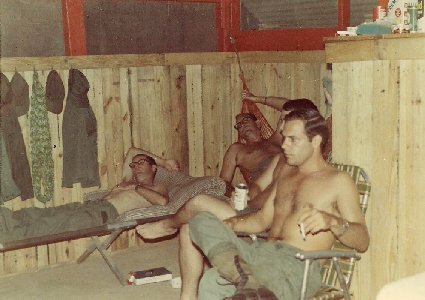 |
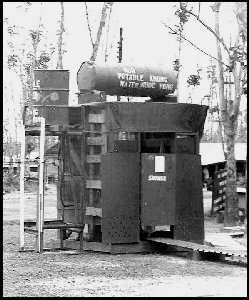 |
LEFT: The
"officers" shower... basically two 55 gallon drums welded
together and warmed by the sun (hopefully)... We later got an immersion
heater that tended to overheat... You had to time your shower just right
to avoid getting scalded.
If it was raining, you didn't bother to dry off before walking back to quarters. RIGHT: Our shower water storage tank had to be filled every day... and sometimes officers got involved in the process. This is the 1st Cav historian from the office next to ours tending the hose. |
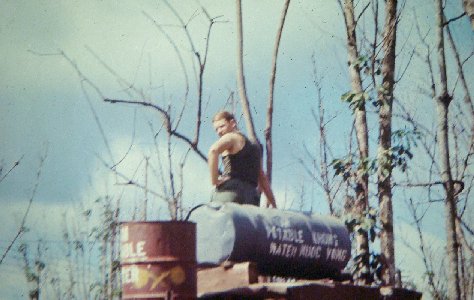 |
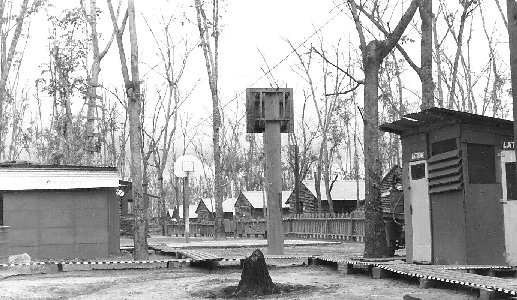 |
LEFT:
And of course, every military facility has to have latrines... Ours were
at least painted and screened. Note the partially burned stump of a rubber tree at center. We didn't many options for
getting rid of the stumps, so in most cases the trees were left alone. RIGHT: Water barrels (for fire use) and latrine. Unlike the classic outdoor privy over a hole in the ground, this design used half 55 gallon drums partially filled with diesel fuel to contain the waste. Periodically (once a week or so) some unlucky soul had to drag them out and burn them out (see smoke at right).
|
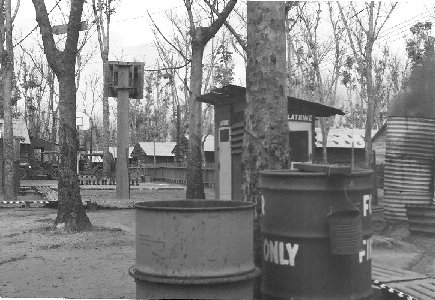 |
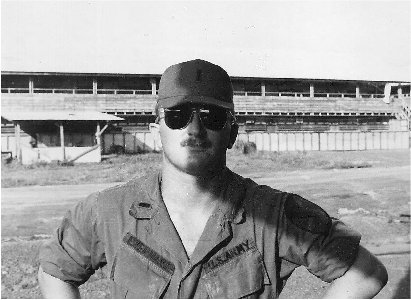 |
LEFT: Picture
of me in Binh Hoa in front of some two story BOQs with real air
conditioning. One of my classmates had been assigned there and he had a
tough life... mostly deciding which movie or club to go to every night. RIGHT: Self portrait..... mostly bored and playing with the camera. |
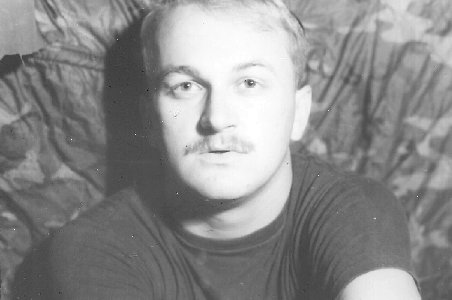 |
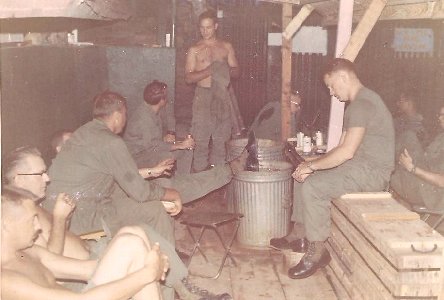 |
LEFT: Going home party.... in this case for 1LT Tinsley.
You were happy for them, but very aware of how much time you had left in
country.
RIGHT: Just another party for someone going home... but not me. CPT Bob Parker in the middle, 1LT Keith Meinert at right, SFC Callahan in background. |
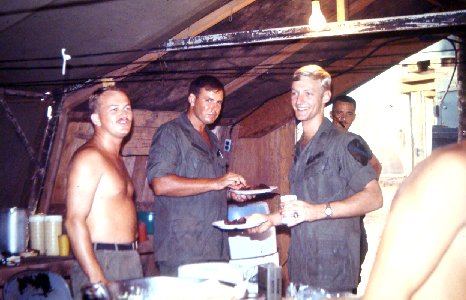 |
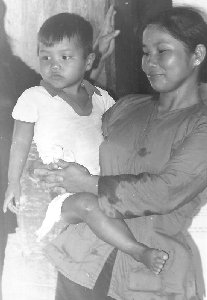 |
LEFT: This is "Mama-san." She was in charge our
our crew of "hooch maids." We lived in "hooches" and
these women were hired from the Phouc Vinh village to clean our quarters, do laundry
and shine boots. Occasionally she would bring her son to work.
RIGHT: This is "Little Bit" ... one of our hooch maids. Her real name was something like Mai Lei, but since she was only about 4 ft 10 inches tall, she was always called by her nickname. Another photo - photo2 - Her father worked as a "lumberjack", cutting timber for a saw mill. These women were very polite and took good care of us. I hope they thought we treated them well. I'll always wonder what happened to them after we left. |
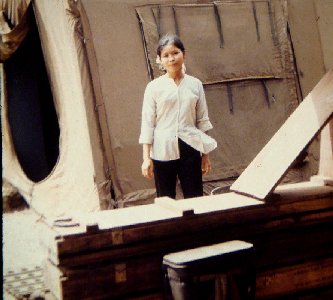 |
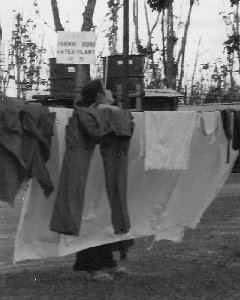 |
LEFT: Laundry
day ... Mama-san was shy about being photographed RIGHT: Assembly line for shining boots. |
 |
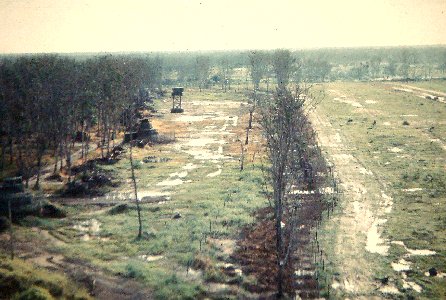 |
LEFT: Flying across the perimeter on approach to our
landing pad at Camp Gorvad. The puddles indicate this was definitely
during the rainy season.
RIGHT: Another aerial view of part of Camp Gorvad and the dead rubber trees. The defoliants we used were developed for deciduous trees in North America, not for tropical growth in Southeast Asia. A defoliated tree in North America will survive; in Vietnam defoliation meant death. On Google Maps recently, it was clear that all the buildings in this area had been removed, but I was surprised to see that many of the dead trees still remained after 40 years! |
 |
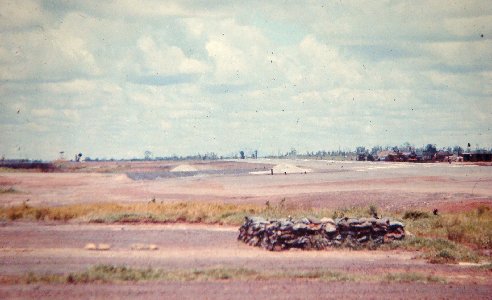 |
LEFT: Flightline for fixed wing aircraft at Camp Gorvad. This
airstrip is now part of a short "super" highway that goes through present day Phouc Vinh
(Google Maps).
RIGHT: This was a view from inside Camp Gorvad, looking through the fence and wire toward part of the town of Phouc Vinh. |
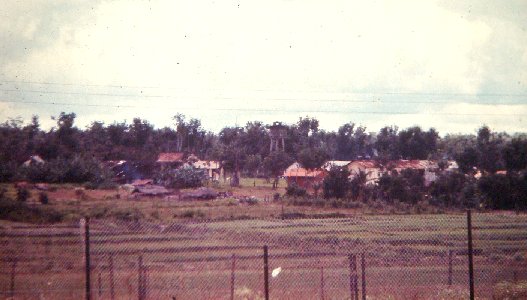 |
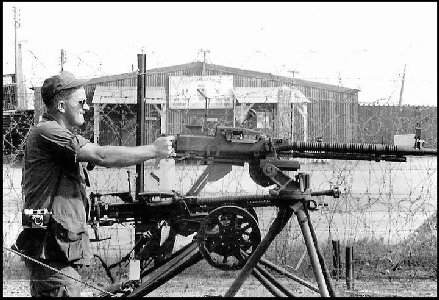 |
LEFT: Me and a ChiCom .51 caliber heavy machine gun on an
antiaircraft mount in a weapons display at Air Cav Headquarters. The
NVA had lots of these that they used to shoot back at us.
The Camp Gorvad PX is across the street on the other side of the barbed wire. I'm carrying a Miranda Sensorex 35 mm camera that lasted about a month....Replaced it with a Pentax SLR that lasted thirty years! RIGHT: At least once while I was there, they actually brought a "snack bar" trailer up from Binh Hoa and set it up outside the PX. The "fast food" wasn't the best, but at least it was different from what we had in the mess hall... We also had a portable barber shop set up in another trailer... |
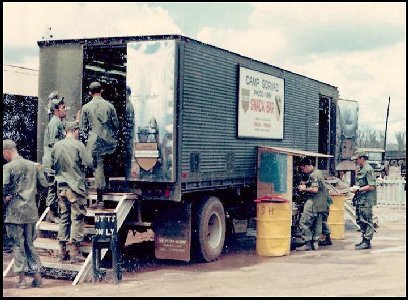 |
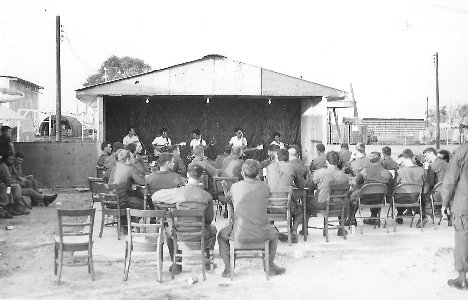 |
LEFT: The USO occasionally brought in entertainment in
the form of rock bands. This one was from the Phillipines. RIGHT: Occasionally there would be entertainment at one of the officer's clubs on base, usually the 11th ACR. |
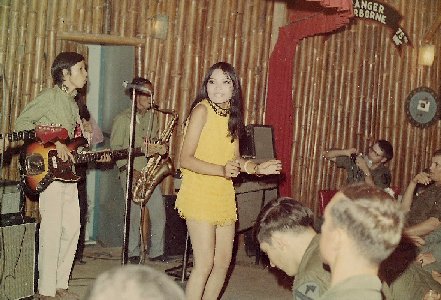 |
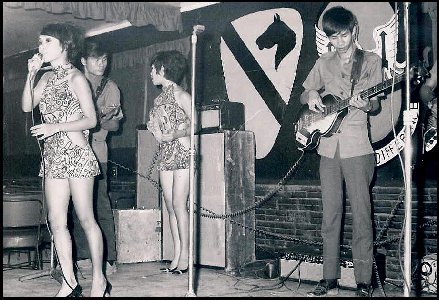 |
LEFT: Another time, another band. Just about all of the
bands were Asian and most did a pretty good job singing American Rock and
Roll...This group called themselves "Yum Yum"
RIGHT: The show was at the "Red Hawk Inn" otherwise known as the 11th ACR officer's club. The music was loud and the beer flowed freely. The song I remember most was the Animal's hit - "We Gotta Get Out Of This Place"..... Imagine a room full of young helicopter pilots, well-lubricated, standing and stomping the their feet to the music.... Awesome..... |
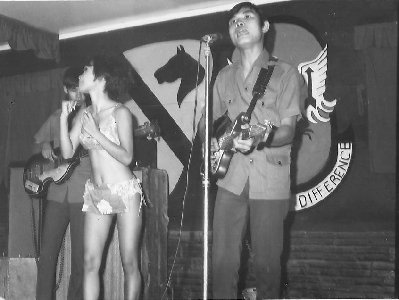 |
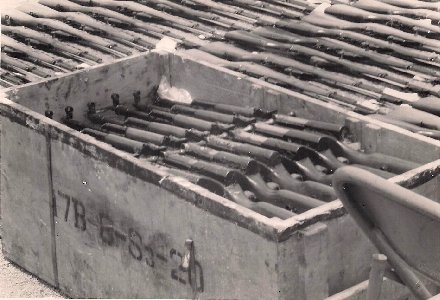 |
LEFT: Spoils
of war.. crates of brand new SKS rifles from Communist China... captured during the
Cambodia incursion in the spring of 1970.
RIGHT: Some of the thousands of weapons captured in Cambodia... Spring 1970. |
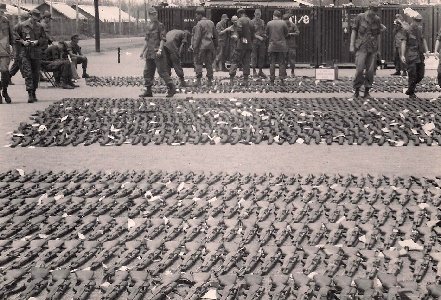 |
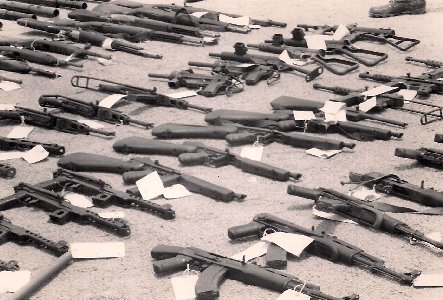 |
LEFT: Captured and re-captured
weapons... Russian, Chinese, American, French, Swedish, etc.. Lots of
them, including the Thompson submachine guns that dated from before WWII.
Most were just stored... They were probably never used again after being captured by the
Viet Cong / NVA.
RIGHT: ChiCom anti-aircraft gun captured by the 1st Cav and displayed at Division Headquarters. The sign at left is at the entrance to the office the the Assistant Chief of Staff for Personnel (G-1). The base PX is in the background at right. |
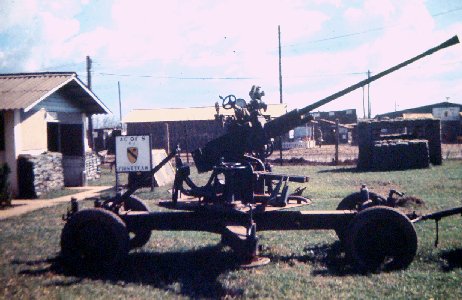 |
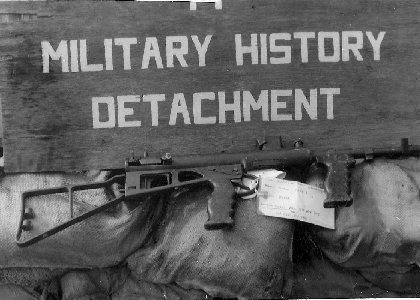 |
LEFT: An
Australian 9 mm sub machine gun RIGHT: A Swedish 'K' 9 mm sub machine gun. Pretty basic design. |
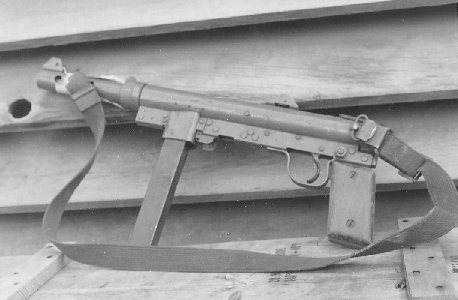 |
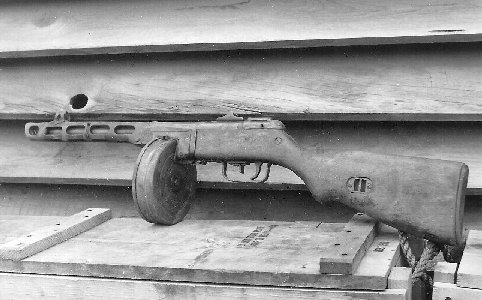 |
LEFT: Chinese
model 50 sub machine gun.
RIGHT: Chinese model 53 light machine gun (7.62 mm) |
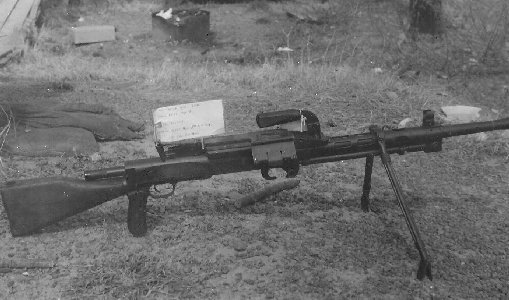 |
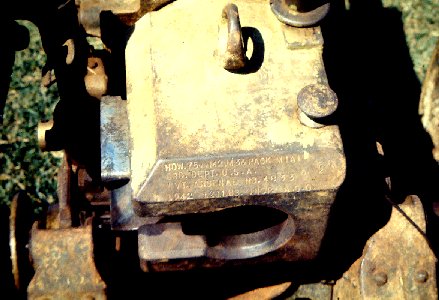 |
LEFT: One of the items captured by the 1st Cav was a
World War II 75 mm Pack Howitzer made in 1942. Although still functional,
it's doubtful that the Viet Cong could get ammunition for it.
RIGHT: "Roaring Forties" Duster M-42 tank armed with twin 40 mm Bofors cannon. |
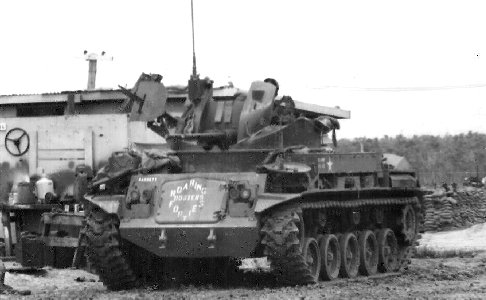 |
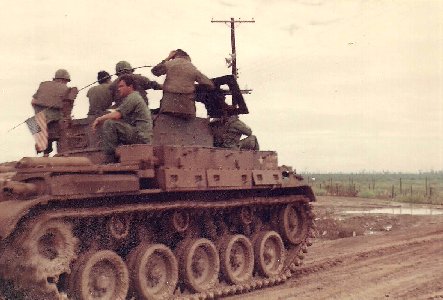 |
LEFT: M-42
- Twin
40 mm Bofors cannon on a tank chassis... Originally designed an anti-aircraft defense
weapon in Europe, it was used in Vietnam as perimeter defense -- nicknamed 'Duster.'
This one is headed out to recover a disabled one.
RIGHT: Duster towing Duster on the way back to Camp Gorvad. |
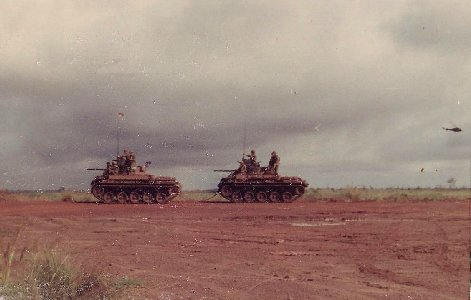 |
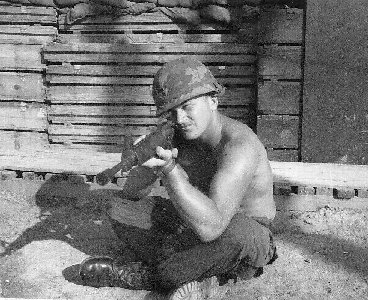 |
LEFT: Me and my M-16.... if you look closely, you'll that
the dust cover is still on the muzzle. The weapon I was issued upon
arrival had been fired so many times
before it was issued to me that the rifling in the barrel was
burned out. It would still shoot, but without rifling, the bullets would
tumble and I had several go through the target sideways. Truth be told, I
never fired it or any other weapon in combat while I was in Vietnam.
RIGHT: I turned my M-16 back in and eventually traded around to get a CAR-15... A nice little rifle favored by our Rangers and Special Forces. As I recall, before I came home, I traded this rifle for enough money to buy my stereo gear. |
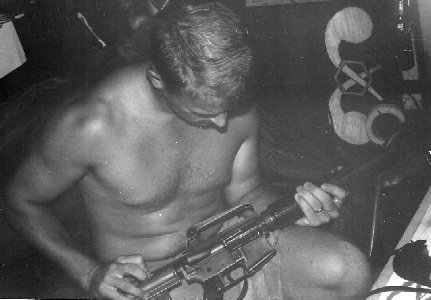 |
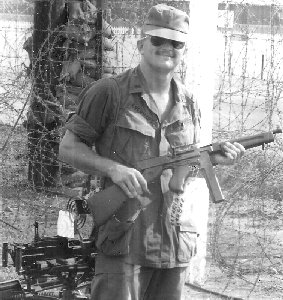 |
LEFT: Me with a captured .45 cal. Thompson submachine
gun. We had one in our unit that we fired several times on the range until
the extractor broke off the bolt.
RIGHT: Me with a captured, Chinese-made SKS rifle from the Cambodian excursion. It is semi-automatic and fires the Russian 7.62 mm/39 cartridge .... Basically the same mechanism as an AK-47, but in a rifle with an 8-round magazine.... They shoot very well... a lot quieter action than an M-1 or M-14.... |
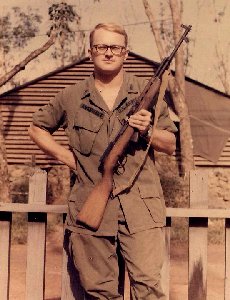 |
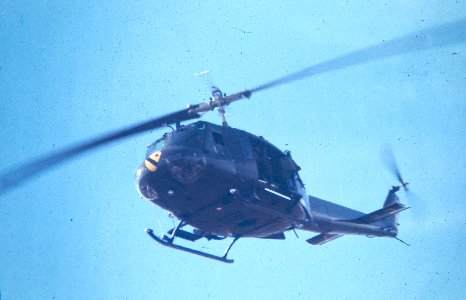 |
LEFT: General Casey's UH-1 helicopter. He was onboard
this aircraft when it hit a mountain on July 7, 1970. About the only
things recognizable at the crash site were the chrome skids.
RIGHT: General Casey's UH-1 on landing approach, coming in over a church in Phouc Vinh/ |
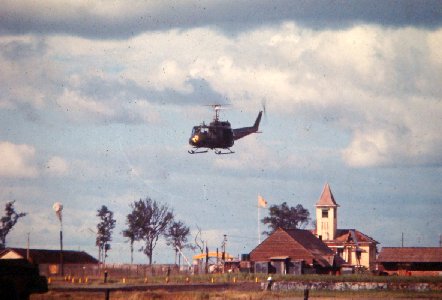 |
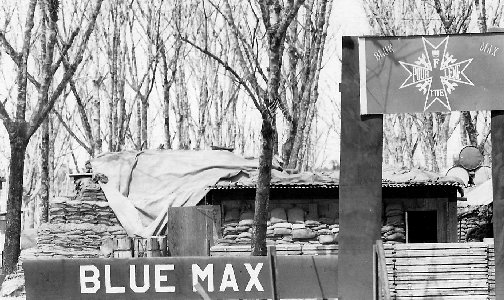 |
LEFT: Headquarters of the 2nd of the 20th Aerial
Artillery (Blue Max)... They flew Cobras and provided much of our close
air support.
RIGHT: The "Blue Max," the Pour le Mérite was Imperial Germany's (WWI)) highest military decoration for valor. The nickname comes from the blue color of the cross on the award itself. Note that Blue Max and the symbol are posted on discarded helicopter blades in front of their headquarters. |
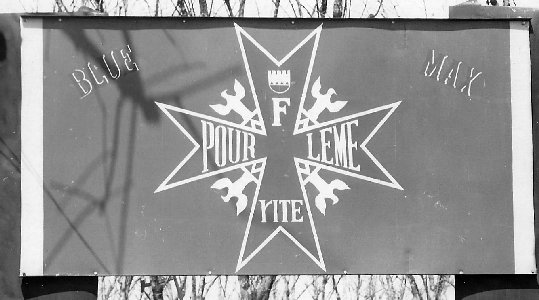 |
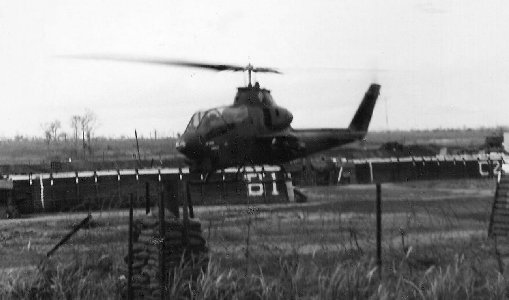 |
LEFT: Blue Max (2/20th) AH-1 Cobra
taking off after re-fueling.
RIGHT: Another 2/20 AH-1 undergoing maintenance. |
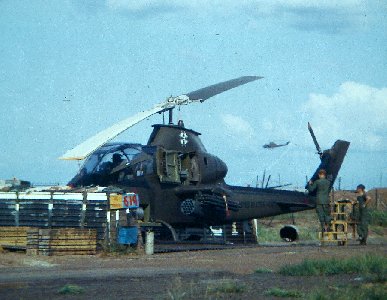 |
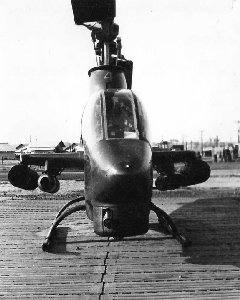 |
LEFT: Business
end of a Cobra... rockets, mini gun and grenade launcher....
RIGHT: An even closer view of the nose turret ... 7.62 minigun and 40 mm grenade launcher |
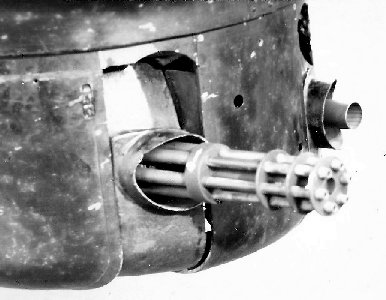 |
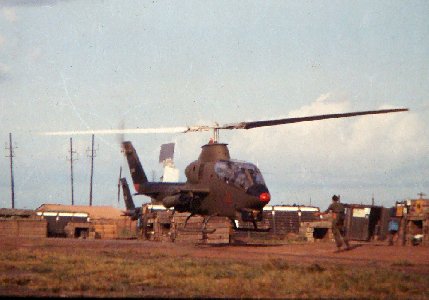 |
LEFT: AH-1 Cobra taking off for mission.-- 1
RIGHT: AH-1 Cobra taking off for mission.-- 2 |
 |
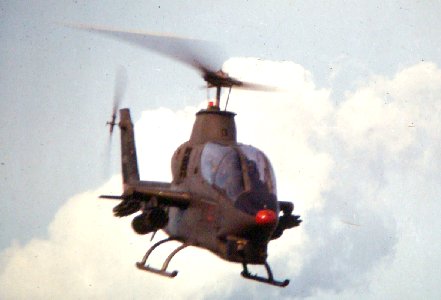 |
LEFT: AH-1 Cobra taking off for mission.-- 3
RIGHT: |
|
 |
LEFT: AH-1 Cobra
sitting outside a hanger at Camp Gorvad. RIGHT: AH-1 Cobra sitting in a concrete revetment in front of the same hangar. Note the hole in the back of the hanger caused by a 122 mm rocket. |
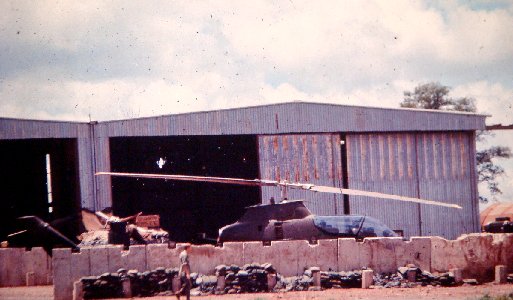 |
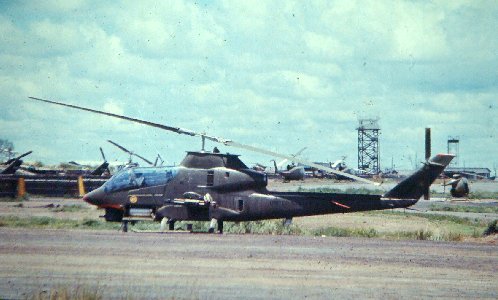 |
LEFT: AH-1 Cobra
parked on the flightline at Camp
Gorvad.
RIGHT: Rear view of an AH-1 Cobra, Camp Gorvad, 1970. |
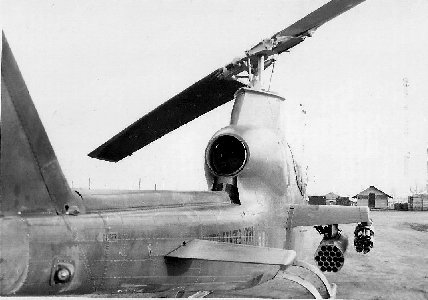 |
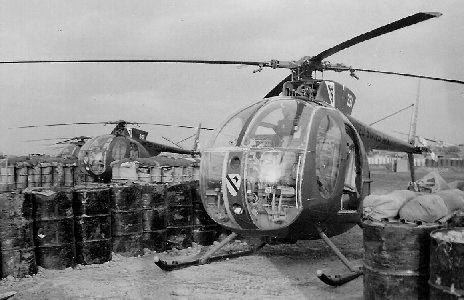 |
LEFT: LOH
(Light Observation Helicopter)... Fun to fly in... a real workhorse
RIGHT: LOH coming in for a landing. |
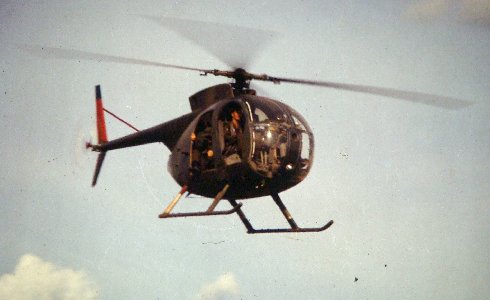 |
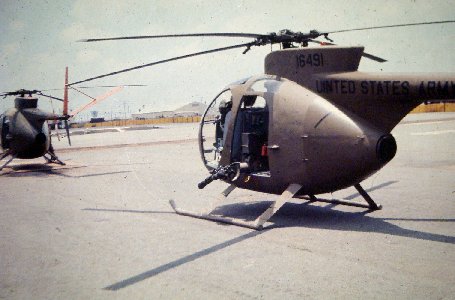 |
LEFT: An LOH armed with a 7.62 mm mini-gun.
RIGHT: Bell OH-58 Kiowa helicopter on the flightline. Originally procured to replace the LOH, it wasn't combat ready in 1970. It has since been greatly improved. |
 |
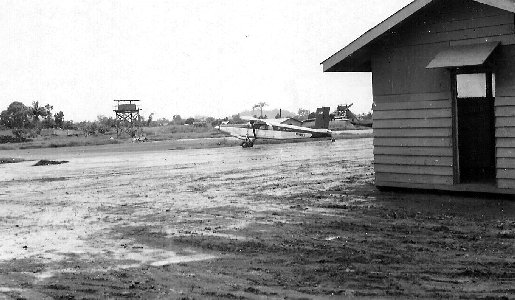 |
LEFT: This photo was taken at our base in Xuan Loc,
one of our smaller Brigade bases. It shows a Swiss built
Pilatus PC-6 Porter STOL aircraft in "civilian markings" getting
ready for take-off. These were used by Air America and Pacific Architects
and Engineers (PA&E), both CIA front companies.
RIGHT: Spiffy looking jeeps parked in front of the offices of the Pacific Architects and Engineers (PA&E) in Xuan Loc. They were supposed to provide most of the utilities at U.S. bases in Vietnam, but were also a front for the CIA. In most cases, they were known as "Promises, Alibis and Excuses." |
 |
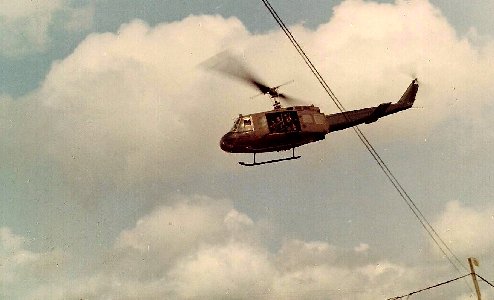 |
LEFT: Unmarked UH-1 helicopter on approach to Camp Gorvad.
Probably being used by Special Forces or the CIA.
RIGHT: Loading up a Huey for a spray mission at Phouc Vinh / Camp Gorvad. |
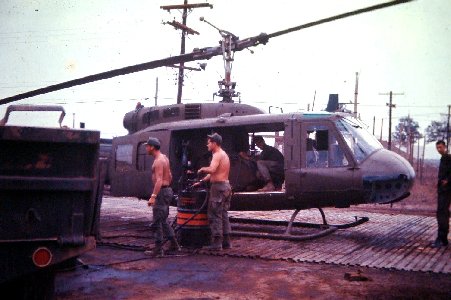 |
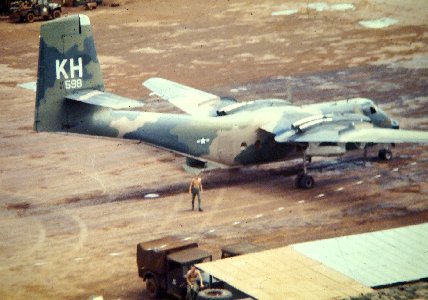 |
LEFT: The de Havilland Canada DHC-4 Caribou was used
extensively in Vietnam.
RIGHT: Caribou on landing approach. |
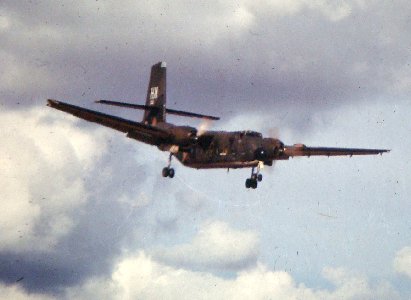 |
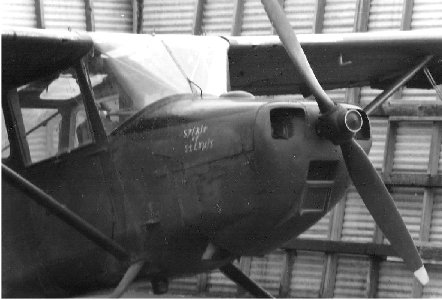 |
LEFT: Cessna O-1 Bird dog single-engine light observation
aircraft. Relatively old, but simple to maintain and very useful. They were nice to have around when the troops on the
ground needed help.
RIGHT: Another view of the same aircraft pulled outside of its revetment. This one belonged to the FAC (Forward Artillery Controller) for the 2/20th Artillery. |
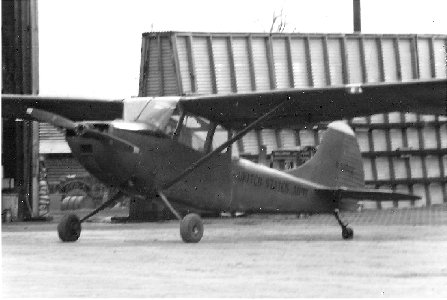 |
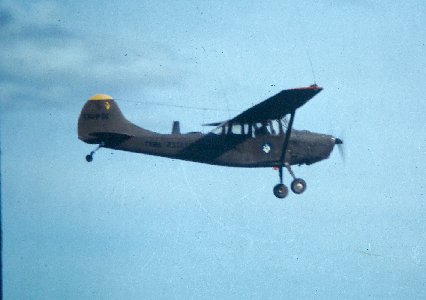 |
LEFT: Cessna O-1 Bird dog single-engine light observation
aircraft in flight.
RIGHT: Cessna O-2 Skymaster twin-engine (puller-pusher) observation aircraft. |
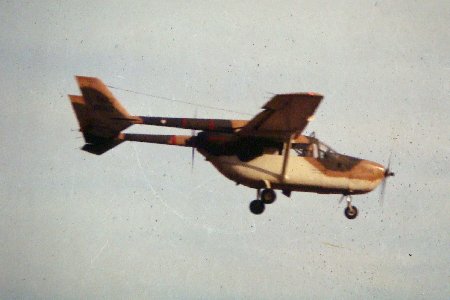 |
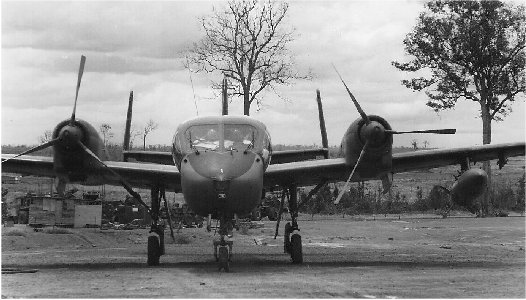 |
LEFT Grumman OV-1 Mohawk light attack aircraft nose view
(Side View)
RIGHT: Grumman OV-1 Mohawk light attack aircraft. |
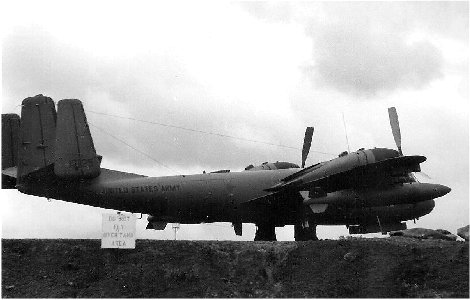 |
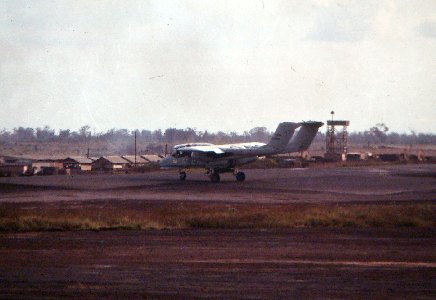 |
LEFT: OV-10 Bronco twin engine aircraft used for reconnaissance
and ground support.
RIGHT: OV-10 Bronco on approach to runway at Camp Gorvad. |
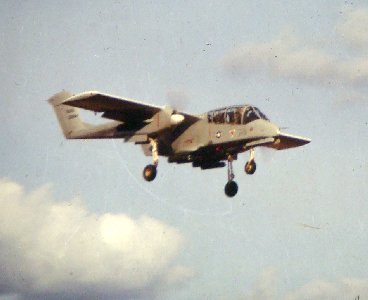 |
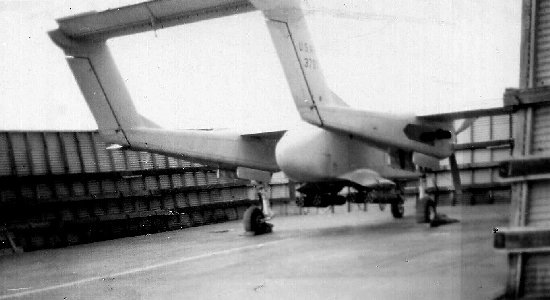 |
LEFT: OV-10 parked in a revetment.
RIGHT: OV-10 undergoing some maintenance on the flightline. |
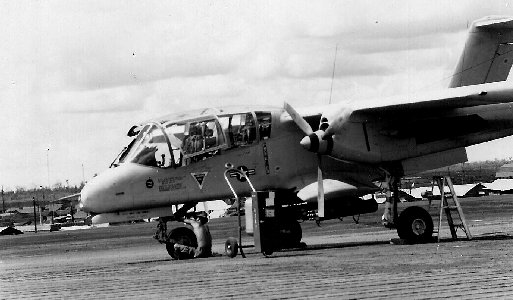 |
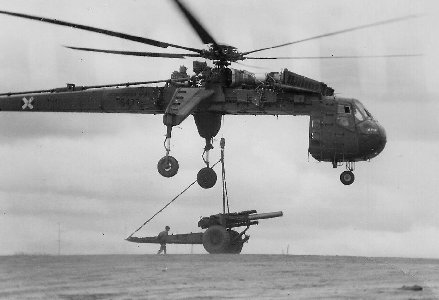 |
LEFT: Sikorsky S-64 heavy lift helicopter loaded with a
155 mm howitzer.
RIGHT: Sikorsky S-64 landing to refuel at FSB Buttons. Nui Ba Dinh (Black Virgin) Mountain is in the background. |
 |
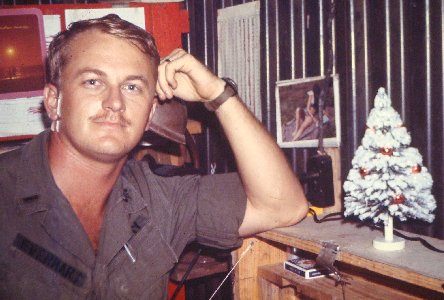 |
LEFT: Christmas was approaching and my Mom actually sent
me a miniature Christmas tree. It was difficult to get into the
season while stuck in hot, humid Vietnam, but it helped.
RIGHT: Christmas tree on my desk, December, 1970. |
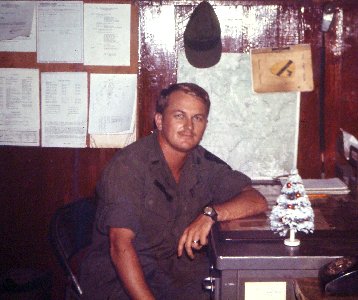 |
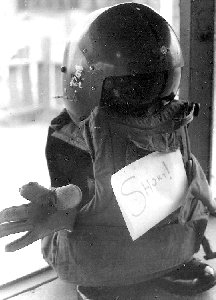 |
LEFT: Short-timer Sam... so short you can get lost in
your boots! Note the WuShock decal on my helmet (Wichita State University
Shockers). We lost a bunch of guys on our football team and coaching staff in a tragic airplane crash
on October 2, 1970.
RIGHT: Finally, the day after Christmas, I took my last helicopter ride down to the 90th Replacement Center in Binh Hoa. The place was crowded and the military was trying very hard to get people, especially the enlisted men, out and home before the new year. Enlisted personnel had the priority at this point, so I spent 5 days waiting and watching movies. I think I averaged three movies a day! At least the theater was air-conditioned. |
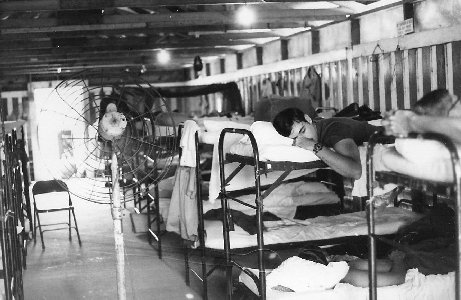 |
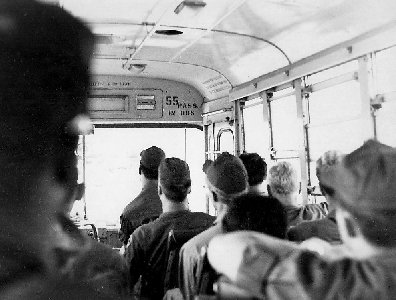 |
LEFT: Finally, I was assigned a flight home and got on
the bus to the Tan Son Nhut Air Base on New Year's Eve, 1970.
RIGHT: We waited several more hours in the boarding area. Everyone was pretty somber at the time, just waiting. |
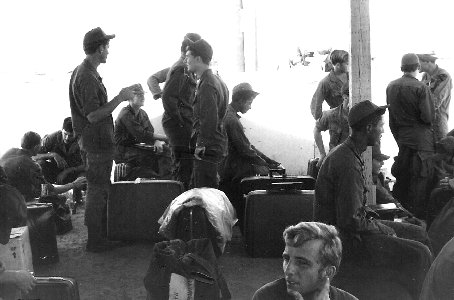 |
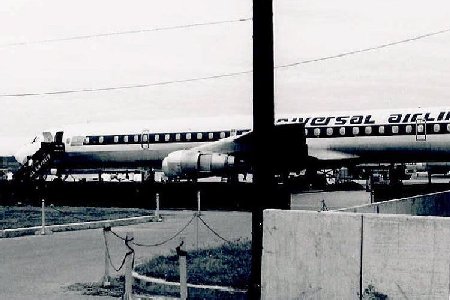 |
LEFT: Someone else's Freedom Bird. After watching three planes load and
depart, we were
told that our flight had finally arrived.
RIGHT: There was a big cheer for the Northwest Airlines 707. Our Freedom Bird... My final assignment was "Aircraft Commander" for the flight home. I was the only officer among the two hundred servicemen on board. There were absolutely no problems. Everyone was intent on getting home as quickly as possible. There was an even bigger cheer when we left the ground! We flew to Tokyo, Japan, where it was still New Year's Eve. When we got off the plane, it was snowing! Fortunately, I was wearing my dress uniform and didn't mind the cold. I think everyone else was in jungle utilities or summer khakis. |
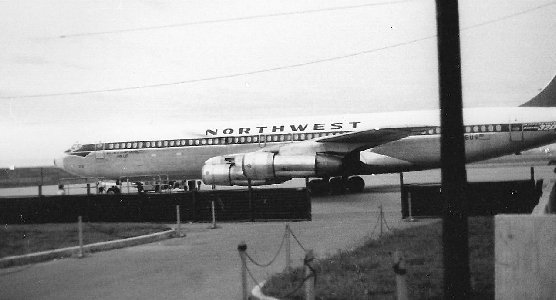 |
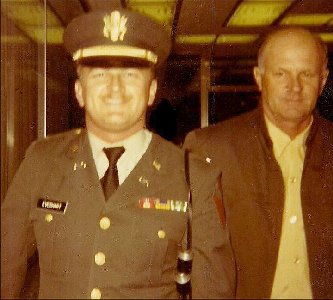 |
From
Japan, we flew to Seattle, refueled and then to San Francisco. It
was still New Years Eve! I was able to process out of the Army the
next day and boarded a flight for Kansas late that afternoon on New Years
Day, 1971. It
was about 7 PM when I arrived in Wichita. The family was there to meet me.
LEFT: January 1, 1971.... Finally made it home... Dad's (World War II Marine) expression hadn't changed much in a year ... but I know I was sure happy to be back! RIGHT: Two weeks later, I'm hitting the books again as a grad student and graduate assistant, on the GI Bill ..... Big change from jungle heat and humidity to the cold Kansas winter.... and then in February we had 13 inches of snow! |
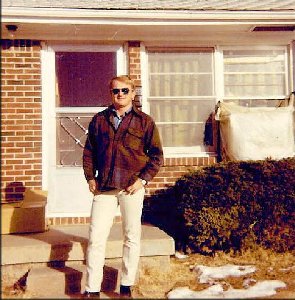 |